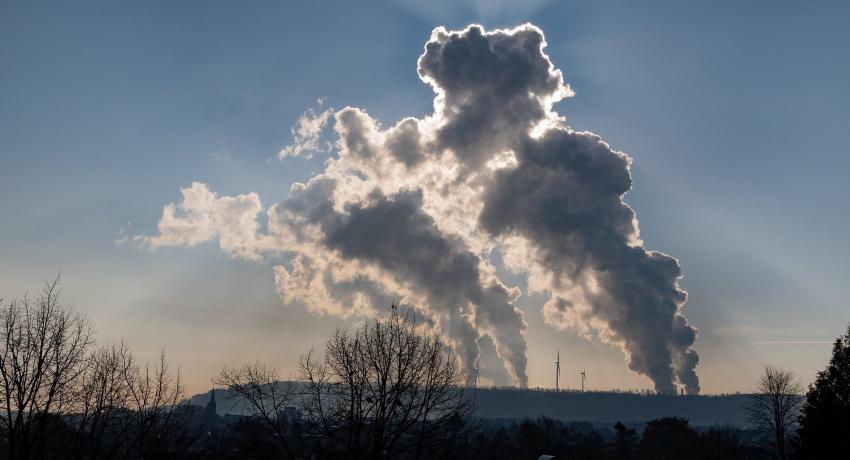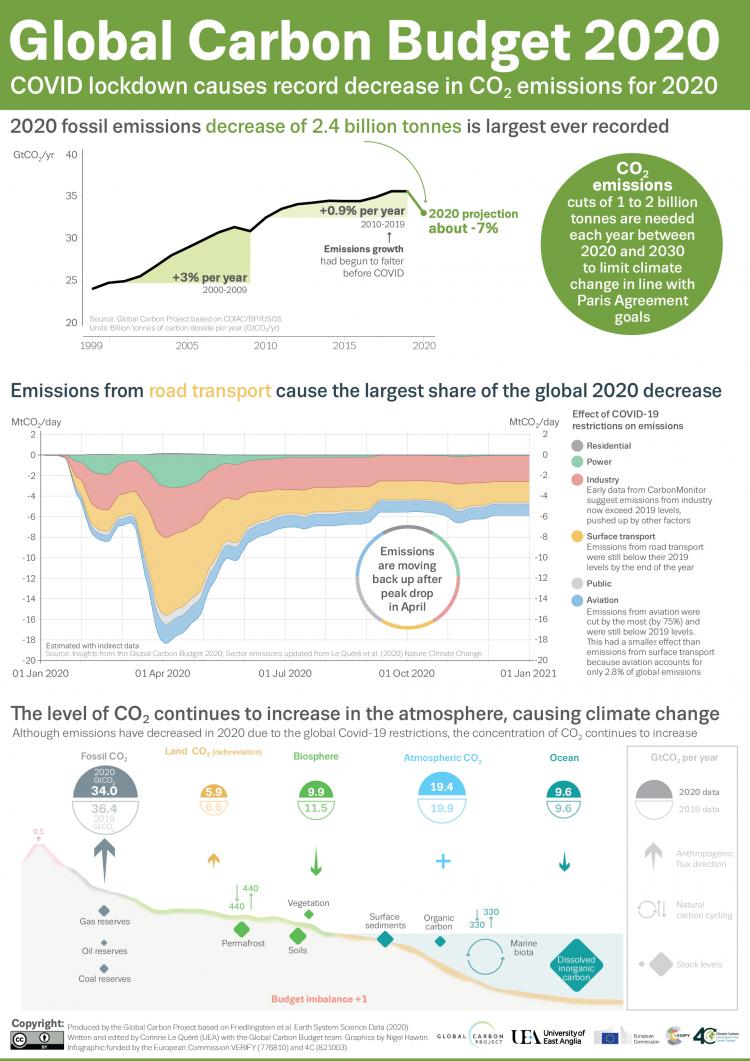COVID-19 restriction measures caused an unprecedented drop of 2.4 billion tonnes of CO2 in 2020. Cuts in global emissions of the order of 1 to 2 billion tonnes are needed each year until 2030 to meet Paris Agreements and limit climate change.
Global fossil CO2 emissions are expected to decline approximately 2.4 billion tonnes of CO2 (GtCO2) in 2020, a record drop caused by COVID-19 confinement measures in place. It means that this year fossil CO2 emissions are predicted to be 34 GtCO2, 7% lower than in 2019. These are the main results of the 15th edition of the Global Carbon Budget, which has been released on 11 December by the Global Carbon Project.
A decrease in emissions of 2.4 GtCO2 has never been seen before. Significant previous drops were 0.5 (1981 and 2009), 0.7 (1992), and 0.9 (1945) GtCO2. The decline in 2020 appears more pronounced in the US (–12%), EU27 (–11%) and India (–9%), with the extensive COVID-19 restrictions enhanced by pre-existing trends, and least pronounced in China (–1.7%), where restrictions measures occurred early in the year and were more limited in time.
The peak of the decrease in emissions in 2020 occurred in the first half of April, when lockdown measures were at their maximum, particularly across Europe and the USA. At that point, daily global fossil emissions were about 17% below their mean 2019 levels.
The transport sector caused the largest drop. At the peak of the COVID lockdowns. emissions from surface transport (21% of global emissions) were cut up to half, while emissions from aviation (2.8% of global emissions) were cut by about 75%. Emissions from industry (22% of global emissions) and power production (44% of global emissions) drop by 30% and 15%. respectively.
Emissions were estimated by the Global Carbon Project using four methods: three using indirect data (such as mobility trends), and one based on reported monthly emissions by October for China, USA, EU27, and India.
Progress since the Paris Agreement
Five years since the adoption of the Paris Agreement, growth in global CO2 emissions had begun to falter. For the decade prior to 2020 (2010-2019), fossil CO2 emissions were decreasing significantly in 24 countries with growing economies.
The 2020 slowdown in global CO2 emissions, the effect of pre-existing climate policies, the net zero commitments by countries responsible for over 60% of the global emissions, and the economic stimulus packages combine to provide a unique opportunity to permanently break with the long-term growth in emissions and start bringing global emissions down.
However, all the elements are not yet in place for sustained decreases, with actions still far from commitments. Cuts in global emissions of the order of 1 to 2 billion tonnes of CO2 are needed each year between 2020 and 2030 to limit climate change in line with the Paris Agreement goals.
“Emissions are slowly edging back to 2019 levels. Government actions to stimulate the economy at the end of the COVID-19 pandemic can also help lower emissions and tackle climate change. Incentives that help accelerate the deployment of electric cars and renewable energy and support walking and cycling in cities are particularly timely given the extensive disturbance observed in the transport sector this year,” said Prof Corinne Le Quéré, Royal Society Research Professor at UEA’s School of Environmental Sciences, who contributed to this year’s analysis.
The level of CO2 in the atmosphere, land and ocean continue to rise
Despite the significant decline in emissions in 2020, the level of CO2 continued to increase in the atmosphere by about 2.5 parts per million (ppm) this year. Emissions were still high (around 2012 levels when including land-use change) leading to a significant increase in the atmospheric CO2 level.
Lead researcher Prof Pierre Friedlingstein, of the University of Exeter, said: “Although global emissions were not as high as last year, they still amounted to about 39 billion tonnes of CO2, and inevitably led to a further increase in CO2 in the atmosphere. The atmospheric CO2 level, and consequently, the world’s climate, will only stabilize when global CO2 emissions are near zero.”
Land and ocean carbon sinks continue to increase consistently with emissions, absorbing about 54% of the total anthropogenic emissions in 2020. Emissions from land-use changes in 2020 were below 2019 levels and similar to the previous decade at about 6 billion tonnes of CO2..Measures to better manage land could both halt deforestation and help increase the CO2 sink from regrowth.
The Global Carbon Project
The Global Carbon Project is an international research project within the Future Earth research initiative on global sustainability, and a research partner of the World Climate Research Programme. It aims to develop a complete picture of the global carbon cycle, including both its biophysical and human dimensions together with the interactions and feedbacks between them.
The Global Carbon Budget 2020 is the 15th edition of the annual update that started in 2006. Data was published on 11 December in the journal Earth System Science Data.


